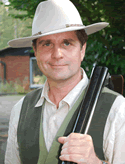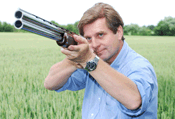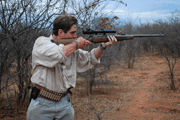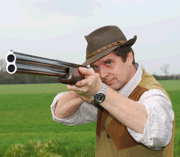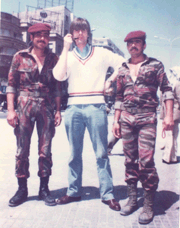Ten Tips to Improve Your Clay Shooting - How to Hit More Clays! by Mike Yardley
Rule 1: KEEP YOUR EYES ON THE BIRD - In the context of shotgunning vision is a skill. We have to train our eyes to sustain fine focus on a moving object: it is not as natural an ability as you may think. It requires discipline and practice. As an aid to consistent visual contact look for the ridges on the target, or any reflected light that may be visible on its surface.
Rule 2: as Lord Walsingham famously noted: DON’T CHECK - In other words do not stop your swing. Many clay busters do not finish the shot well. They take the head off the stock too early and the result as the gun rises and stops is almost always a miss over the top and behind. This leads us directly to
Rule 3: KEEP YOUR WEIGHT WELL FORWARD AND YOUR HEAD ON THE STOCK - This will encourage a fluent, unchecked, swing. Don't bend forward or stick your bottom out. Keep the back straight and bring the weight on to the ball of the front foot.
Rule 4: BE POSITIVE - A confident mental attitude encourages a good stance, good vision and a good follow through as well as an expectation of success. Hesitation or anxiety, on the other hand, brings the weight and focus back and causes the gun to stop. You have far more to gain by maintaining a positive attitude when clay shooting than by worrying neurotically about choke/gun/cartridges.
Rule 5: therefore is CUT THE CLUTTER - Focus only on those simple things that will help you and forget all the distractions.
Rule 6: KEEP YOUR SHOULDER LEVEL AS YOU SWING - Many drop a shoulder because the are standing poorly in relation to the target. The upper body should move like a tank turret. This takes us to
Rule 7: USE YOUR FRONT ARM WELL AND MAKE A SPECIAL EFFORT TO CONTROL THE TIP OF THE GUN - Good shots always seem to shoot with a graceful economy of movement. They use the gun like a wand.
Rule 8: DEVELOP A ROUTINE AND STICK TO IT - Stand towards the spot where you want to kill the bird (so that one unwinds into the bird), bring the gun back to the place where you first see the target clearly (where you first achieve fine focus) and direct your eyes into the zone where you see it as a blur. Before calling for the bird, visualise a kill in your mind's eye.
Rule 9: CALL FOR THE BIRD AS YOU MEAN TO SHOOT IT - If you call for the bird in a hesitant manner you are likely to shoot it in the same way. Similarly, if you squawk 'PULL!!!!' you are unlikely to perform with finesse. The call should be smooth and confident.
Rule 10: (skeet and sporting): SHOOT EVERY BIRD WITH GOOD TIMING - For gun down shooting, one should always shoot to three beats - one:two: threeee - changing the tempo according to the target. Far too many sporting shots shoot to two beats, bringing the gun to the shoulder too fast and then slashing wildly at the target. DON'T RUSH!
Let us now briefly consider the different disciplines. Sporting: the variation in lead required from stand to stand can cause major problems. Most targets (including very slow birds) are usually missed behind, but quartering birds and rabbits may often be missed in front. If you are unsure about lead, consider the distance to the bird. If it is crossing 40 yards away you probably need to be something in the region of 8 feet in front, more if it is very fast (as midis and battues tend to be). I do not usally advise looking for lead deliberately inside 30-35 yards. It is better to rely on natural hand to eye co-ordination. Timing is always important, everything should be shot to three beats with your eyes riveted to the bird. Use the cage to maximum advantage and stand to favour the harder bird if there is not time to move the feet. Never start with the gun muzzles above the line of the bird.
Skeet shooters can develop a very specific routine because they know that the birds will be presented within the rules. Do not hold the muzzles of the gun too low on High 1. Do not wind too far back on High 2 (the shot is best taken ‘on the front edge’ over the centre peg). The pair on 4 should always be taken smoothly. Brush the first bird out of the air then the other. On the pairs stand to favour the second bird. On Low 6, as with High 2, be careful not to take the gun too far back. Don’t be hurried on any station. Set your own pace.
Trap shooters should pay particular attention to their gun fit. They should always relate their stance to the central marker (my simple system is to point the leading foot to the marker from every position on DTL) and they should experiment with different hold positions. If targets are coming out low, a low hold will make them much easier. Similarly, a high hold may make high rising birds easier. Again, do not rush. Always let your eyes - which should look about 6 feet in front of the trap house in anticipation of the target - dictate the speed of shooting. Focus, then move. I do not advise looking for lead deliberately on any trap bird, trust your eyes.
NEVER POINT A GUN AT SOMETHING YOU ARE UNWILLING TO DESTROY
ALWAYS CHECK THAT A GUN IS UNLOADED AND UNOBSTRUCTED, WHEN YOU PICK IT UP, WHEN IT IS PASSED TO YOU AND WHEN YOU LEAVE THE STAND.


